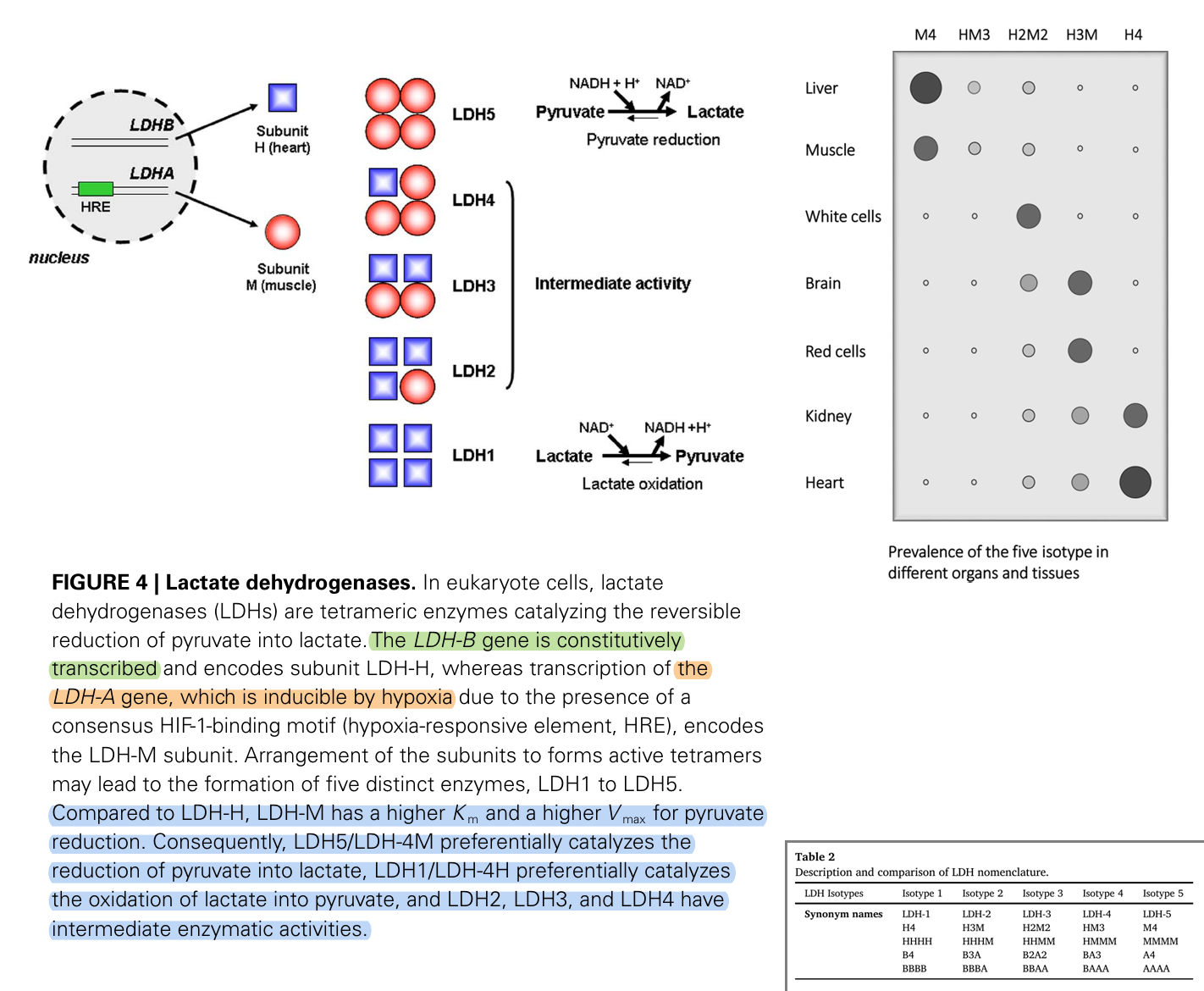BIOHACKING by Nathan Hatch, "F*** Portion Control"
-
Amazoniac, you have much more knowledge of chemistry than I do. I would be interested in knowing whether you might have an opinion regarding the use of sodium acetate as a means of lowering lactic acid as recommended by Hatch in the book?
-
@S-Holmes said in BIOHACKING by Nathan Hatch, "F*** Portion Control":
@Amazoniac This is beginning to sound personal. What harm is there in trying Nathan's hacks? Are they dangerous? He uses food and a few low dose supplements. Pretty scary!
Re balding, he still has full, thick hair (unlike everyone's favorite low A "detective.") So he must be doing something right. How else would you expect him to prove his claim?
Perhaps you're one of those fortunate enough to have never suffered from metabolic syndrome. I, like Nathan have had it my entire life. I have been able to control it using various "unproven" methods (homeopathy is one) for 20 plus years.... until Covid. Like Nathan, I have suffered from many maladies, including Epstein Barr, chronic sinusitis, cancer, Meniere's...my body is not kind to me. Like Nathan, RP helped me survive, but sadly, we did not thrive. It appears Nathan is now thriving. If he has gone off the reservation...doesn't have "research" to support his claims... why should anyone care? If he makes said claims based on his own experiences, I'm happy to help test his theories.
Why must you constantly challenge my posts in this thread? Is it your intention to direct others away (who, like me and Nathan, have tried literally everything to little or no avail)? What if he can help them with his simple, cheap and self tested solutions? As a homeopath for more than 30 years (it has kept me alive and symptom free for MOST of my life...trust me, no small feat) I trust empirical evidence over 95% of the lab research available. Two of my sisters took their own lives, one in 2017 and the other in 2019, one overdosed and the other with a gun. They both had metabolic syndrome and just finally lost hope. What if Nathan's work can save others who have lost hope?
So in conclusion, I do not believe your heart is in the right place. Also...don't you have ANYTHING better to do?
If you go back to my first post in this thread, it was already clear that I find his experimentations valid, but the explanations and how they are communicated in ruling tone are an insult.
You post something and it's meant to be read. The challenge is to illustrate why it's worth to be wary of the concepts put forward by this author. I also wrote that helping others through shared experiences doesn't give the person a free pass to confuse them out of carelessness.
In addition, his articles aren't based on self-experimentation alone, it's an author who declared to also go by "scientific research" and to be well-read. He's making use of researchers' works, twisting them and not informing the origins, which would encourage verification.
Can't you tell the difference between these?
- What worked for me in reversing hair loss
- "THE CURE FOR BALDNESS"
How do I expect him to prove his claim? I would like to witness the savior to gather a group of 10-20 volunteers and deliver the promise.
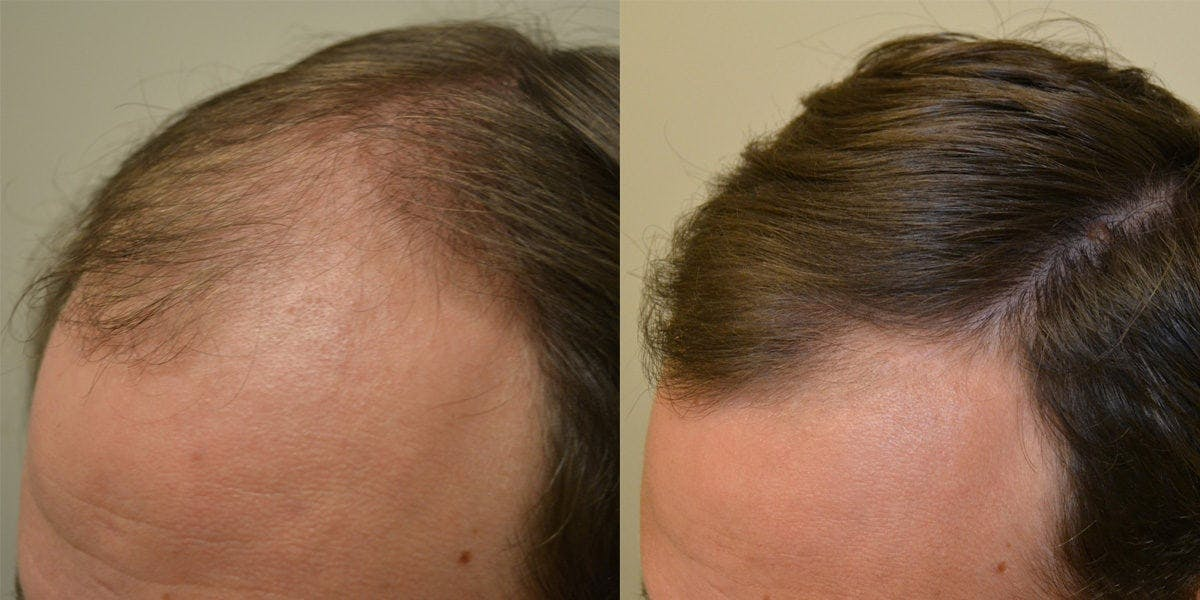
The position of my heart doesn't invalidate criticisms, but I can tell you that it's in the right place for thoughtful authors.
-
@Amazoniac said in BIOHACKING by Nathan Hatch, "F*** Portion Control":
The horseradish peroxidase used in the only backup material linked was for assisting in the detection and measurement—Polymyxin B (derived from gram-positive bacteria) is the actual endotoxin binder and inactivator of these experiments. The researchers even wrote that "horseradish peroxidase alone [..] did not bind to lipid A" and made explicit its function as a "reporter enzyme." He's misattributing the effects of Polymyxin B to horseradish (peroxidase).
I insist: be watchful with the interpretations of this author.
On the practical aspect, lots of promises and not enough demonstration. Is there any health problem that he hasn't found the cure yet? As an example, he has "THE CURE FOR BALDNESS".
"Yes—I have figured out why hair loss happens and how it can be restored!"
Then, why not show us in practice here? Imagine how many guys around the world would be willing to discontinue finasteride for what he has to offer and document the restoration for others.
Appreciate the correction and public service. Horseradish may be harmless enough for most but this is a tiny example of where lack of verification can waste time and potentially get someone into trouble.
-
@vocedilegno said in BIOHACKING by Nathan Hatch, "F*** Portion Control":
Amazoniac, you have much more knowledge of chemistry than I do. I would be interested in knowing whether you might have an opinion regarding the use of sodium acetate as a means of lowering lactic acid as recommended by Hatch in the book?
What I do: consult anesthesiology book , find all there and parrot))
Sodium acetate can be an effective substitute for baking soda, but it's chosen over the latter for secondary reasons: availability, stability, price and ease of production. Otherwise, baking soda would be preferred.
The primary purpose of such salts in conditions that tend to 'lactate acidosis' would be to counteract acidity rather than lactate. The metabolism of sodium acetate is complex relative to that of baking soda, that reaches the stomach, reacts with acid instantaneously, and from then onwards it behaves as dietary sodium chloride.
An incomplete comparison:
Baking soda Sodium acetate Speed of action x Tolerance x Predictability x Ease of metabolism x CO2 recovery x Gut modulation x I don't have clear how carbon dioxide produced after these salts would affect lactate. The principle seems to be based on the dissociation of oxygen from hemoglobin to tissues to promote oxidative metabolism, but we would have opposing factors:
- Additional carbon dioxide (↑CO2) increases oxygen dissociation (as if tissues could handle more of it)
- Alkalinization (↑pH) decreases oxygen dissociation
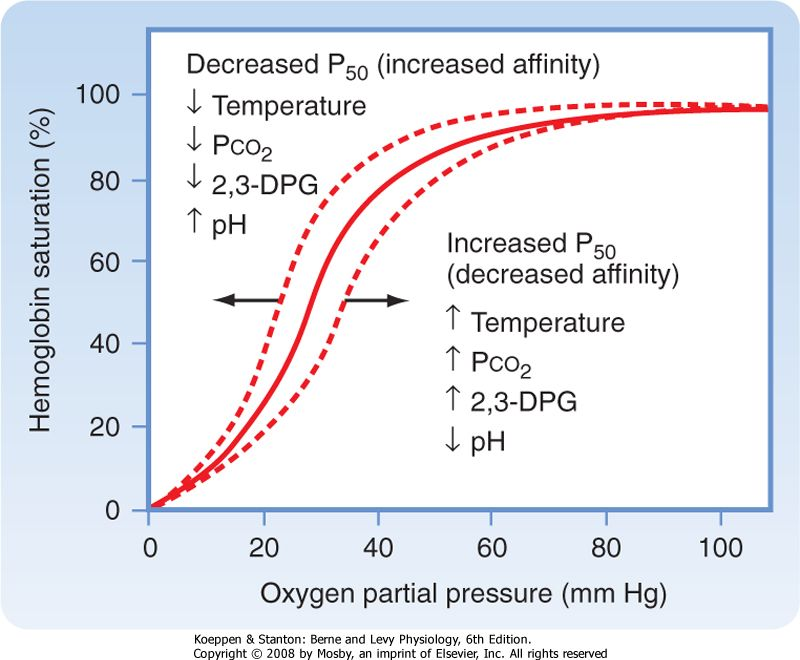
When baking soda is injected, extra hydrocarbonate ions would react with protons to produce carbon dioxide. This happens in the stomach, but part of the carbon dioxide is lost. So, with ingested baking soda, we might not be able to count on substantial amounts of extra carbon dioxide.
Alkalinization tends to increase the rate of glycolysis (glucose → pyruvate) and it may have an effect on cells that are already overproducing lactate from pyruvate. Acetate would have an edge in this regard for yielding CO2 locally. On the other hand, an elevation in the ratio of acetyl-CoA to CoA can further inhibit pyruvate oxidation, as suggested in this extreme version.
With the liver cells becoming acidic, they appear to shift from influx to efflux of lactate.
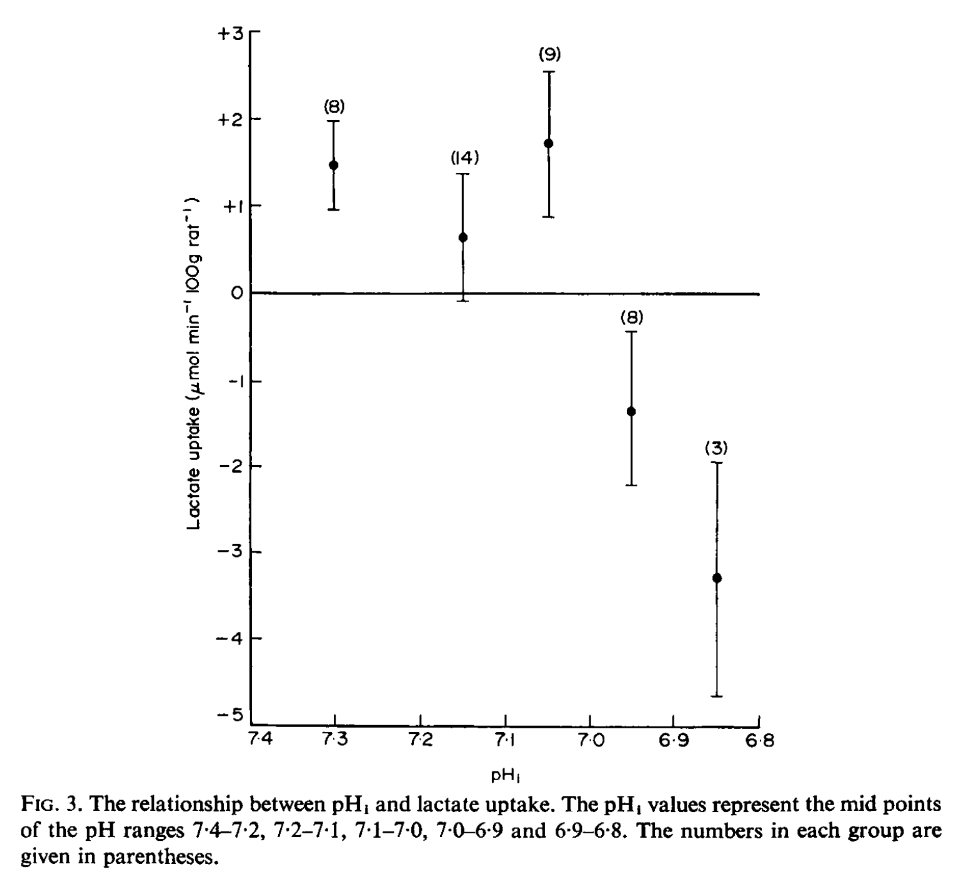
This could be an issue considering that the liver is a major site of lactate clearance. It would be a point in favor of ingested baking soda (alkalinization with less carbonic acid or carbon dioxide recovered). However, since acidification can slow down the rate of glycolysis and control lactate synthesis, sodium acetate would be advantageous because of the proton consumption and carbon dioxide production.
I don't remember how much L-lactate can be urinated intact, yet the additional sodium from either salt would help in this regard. But the body must try to conserve lactate to resynthesize glucose.
Sodium acetate has other applications. For example, prior to its popularization in weight loss circles, salts of organic have been extensively used by the livestock industry to shape the gut of animals.
Overall, when it comes to the burden of 'lactate acidosis', sodium acetate would add layers of potential complications to consider. Lowering the doses should also lower the concerns, yet doesn't eliminate them. The main target is acidity and I would favor baking soda to counteract it, while focusing on the more immediate measures that are known to help to deal with excess lactate (people's beloved thiamin, for example).
As a side note, different forms of lactate dehydrogenase occur in tissues:
It may seem counterintuitive for such forms to prevail in liver (as an important organ for lactate clearance), but it's also under the influence of the state of cells:
"Three conclusions with regard to electrophoretic separation of LDH isozymes in mitochondria and cytosol appear appropriate. First, differences in LDH patterns between mitochondria and surrounding cytosol suggest that LDH within mitochondrial preparations did not result from cytosolic contamination. Second, the greater abundance of LDH-1 (H4) in heart than liver is expected on the basis of the high oxidative capacity of cardiac tissue. However, like heart, liver is also a net lactate consumer. Thus, differences in mitochondrial LDH pattern in liver compared with heart may be more related to the gluconeogenic, as opposed to oxidative nature of liver. Third, the ability of mitochondria to convert lactate to pyruvate is governed by mitochondrial redox rather than LDH isoenzyme pattern. This latter conclusion is reached because of similar abilities of liver and cardiac mitochondria to oxidize exogenous lactate despite very different LDH isozyme patterns."
-
This post is deleted! -
I should add to the previous post that if the excess lactate is a consequence of cancer, it would bring more complicating factors to consider in supplementing sodium acetate. You can find therapeutic uses of acetate in this condition, but it can be tricky.
Unlike pyruvate-derived acetyl-CoA—that's formed in the mitochondria (ACSS1), added to form citrate and exported to the cytosol for lipid synthesis—dietary acetate can skip this process and form acetyl-CoA without involving the mitochondria (ACSS2), which would be useful for tumors.
"Intracellular acetate is quickly converted into acetyl-CoA by acetyl-CoA synthetase 2 (ACSS2; nucleocytosolic) or ACSS1 (mitochondrial)."
-
@S-Holmes said in BIOHACKING by Nathan Hatch, "F*** Portion Control":
Come on, Holmes. I suggested a few simple trials in his presence, for us to verify with little method some of the promises, and you send me a link with 5 unrelated cases, susceptible to selection and filled with additional dubious claims? I'm looking for quality, not volume. It's funny, we can sniff the aroma of uncredited Seneff and Gominak in passages just by the wording.
It's also funny that I got more interrogation so far than the individual who is pushing the absurds.
One important discovery in a field is enough for a researcher to be considered exceptional. This guy has declared to have the cure for cancer, metabolic syndrome, diabetes, thyroid disease, kidney disease, autism, baldness, acne, erectile dysfunction, depression, learned hopelessness, PTSD, anxiety, insomnia, addiction, gut dysbiosis, microbial overgrowth, varicose veins, oral disease, viral infections, weight issues, migraine, chronic pain, hyperphosphatemia, and so on.
What's the problem in putting the silver bullets to test in front of us? Anything that works in his moderated bubble should work outside of it too. Is demonstration with a group too much to ask from someone who has the cure for all major conditions?
People are lured to pay to unlock the access to the majority of them. From the recent example:
"Yes—I have figured out why hair loss happens and how it can be restored! But you'll have to buy the book for this one."
If he's confident about what he writes, why he doesn't offer refunds for his $36.. ebook?
"THERE ARE NO REFUNDS GIVEN ON EBOOKS."
Emphasis not mine. And it was underlined as well.
"There are no refunds on eBooks or opened/used books."
In other words, you also can't open the printed book to inspect; it has to remain sealed as your mitochondria under silicic acid. Wouldn't it be the norm for readers to overlook any vulgarity to keep a vitality masterpiece that saves everyone around? It's flamboyant authorship without ownership.
Last week or so I received a promotional email from a proficient author whose book I recommended before. Compare the message:
"If you’re unhappy with your purchase please contact me within 30 days and I’ll refund you in full."
A long time ago I shared a link to some other public book as a comment below one of his articles, something friendly like: 'For readers who want further information on the topic, check out the following material'. He approved comments containing links, but this one was barred. Your savior seems to prefer for his readers to not be directed to detailed information than to divide the spotlight. It only served to reinforce what I already knew about the guy.
A peek at his coaching page is enough to raise suspicion of priorities. The guy keeps a picture of him shirtless, lying down, trying to put a provocative face and sensualize—right beside the description of his advising program and the following words:
"Just like my book the focus of my insight and advice is not on physical appearance"
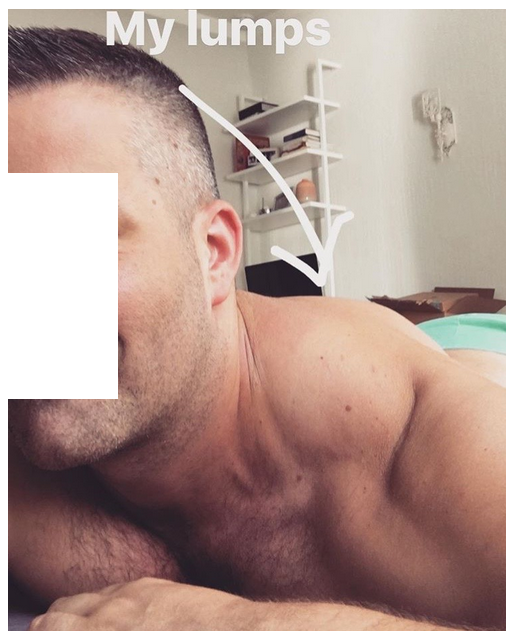
It's a strange way to show the physique. For $100, is he offering health coaching or prostitution services?
Every couple of months we have a new sensationalism released and an enthusiast to pick it up. You're not the first and won't be the last. Both of us are part of the publicity and this helps him to maintain his relevance. Just like the Garrettes, some people don't mind being treated as fools and will hop on board regardless. But if he respected and didn't underestimate the audience, he would moderate the discourse in each assumption and would at least bother reading the summary of the sole source to feature in his publication.
-
Additional material that suggests caution with acetate in cancer:
- Acetate Dependence of Tumors
- Acetate is a Bioenergetic Substrate for Human Glioblastoma and Brain Metastases
- Quantitative analysis of acetyl-CoA production in hypoxic cancer cells reveals substantial contribution from acetate
- Acetyl-CoA Synthetase 2 Promotes Acetate Utilization and Maintains Cancer Cell Growth under Metabolic Stress
I'm aware of Max's endorsement of acetate salts or the experiments with triacetin. However, if the main purpose is to counteract acidity associated with excess lactate, we return to the straightforward way of relying on baking soda (or the potassium equivalent).
By inhibiting lactate dehydrogenase A (⇈), it's possible to increase the respiration rate (measured through oxygen consumption) of some cancer cells, with a proportional rise in ATP production. If cells in these cases are doomed to reliance on glycolysis because of electron leakage from mitochondria and silicic acid is the missing factor, how to explain this phenomenon?
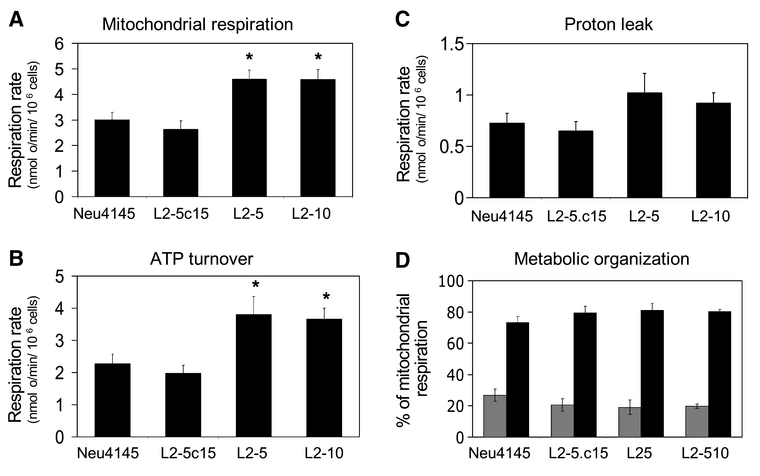
"Figure 4. Bioenergetic analysis of Neu4145 parental tumor cells, derived LDH-A-deficient L2-5 and L2-10 clones, and LDH-A-complemented L2-5.c15 clone
A) Total mitochondrial respiration consists of ATP turnover and proton leak.
B) ATP turnover represents the respiration that is sensitive to the inhibitor of the ATP synthase, oligomycin.
C) Proton leak represents the respiration that is insensitive to oligomycin.
D) Metabolic organization is the fraction of mitochondrial respiration that is used for ATP turnover (black bars) and proton leak (gray bars)." -
This post is deleted! -
This post is deleted! -
S S.Holmes deleted this topic on
-
 A Amazoniac referenced this topic on
A Amazoniac referenced this topic on
-
I ilovethesea referenced this topic on
-
 B brad restored this topic on
B brad restored this topic on
-
Just an admin. note - the author of the topic deleted this topic. Other contributors complained that their posts were also deleted. I went through the topic to delete the original author's posts and restore the posts of the other contributors. In the future, after a topic has reached a few posts, it cannot be deleted by the OP. If the OP of this topic would like their posts restored they can just let me know and I will do so.
-
@Amazoniac said in BIOHACKING by Nathan Hatch, "F*** Portion Control":
What I do: consult anesthesiology book , find all there and parrot
A lot more than that. But still, the best in the business.
A sight to behold. Thank you @brad.
-
Two things that I didn't have the chance to clarify in response to the last posts by the thread blaster:
I wrote that she deliberately accepted to be treated as a fool by an author, not that she's inherently one. Contrary to her pet quack, the "troll" here doesn't underestimate readers. Let us leave the distortions for him.
She also labels my posts as "TLDR". It's because of not reading that she missed twice the parts where I acknowledged the therapeutic acetate uses in cancer, where it had a positive (and not just neutral) impact, but added that it's tricky and suggested caution; cancer cells are heterogeneous in their organization and the effects can be uncertain. Since the question revolved on counteracting excess lactate and the associated acidity, in the context of cancer, I argued that baking soda would be a preferable option for being safer, which it is.
Regarding the author, I contacted him a day before this thread was taken down out of nothing. Claiming to have the cure for so many problems and dismissing an invitation to demonstrate them says it all.
We can then turn to chat bots to communicate in a language that charlatans speak:
"As a health coach, it is essential to uphold ethical standards and provide accurate information to clients seeking guidance on improving their well-being. Making false promises about curing diseases is not only unethical but also illegal in the United States, leading to severe legal consequences such as civil penalties, fines, injunctions to stop deceptive practices, and potential criminal charges. Deceptive practices, such as falsely claiming to cure diseases, can harm clients by offering false hope and undermining their trust in healthcare providers. This can result in clients losing time in pressing medical circumstances, delaying them from seeking appropriate treatment and potentially worsening their health outcomes. Moreover, such deceptive practices often prey on vulnerable individuals who are in dire need for solutions, further exacerbating their distress and potentially leading to financial exploitation ['NO REFUNDS ON BOOKS OR COACHING']. It is crucial for health coaches to be transparent, truthful, and evidence-based in their recommendations to clients, ensuring they prioritize community health and safety while promoting wellness effectively."
The first publication from a compilation of William F. Koch's writings (I couldn't upload the file. Save it in case the link gets broken):
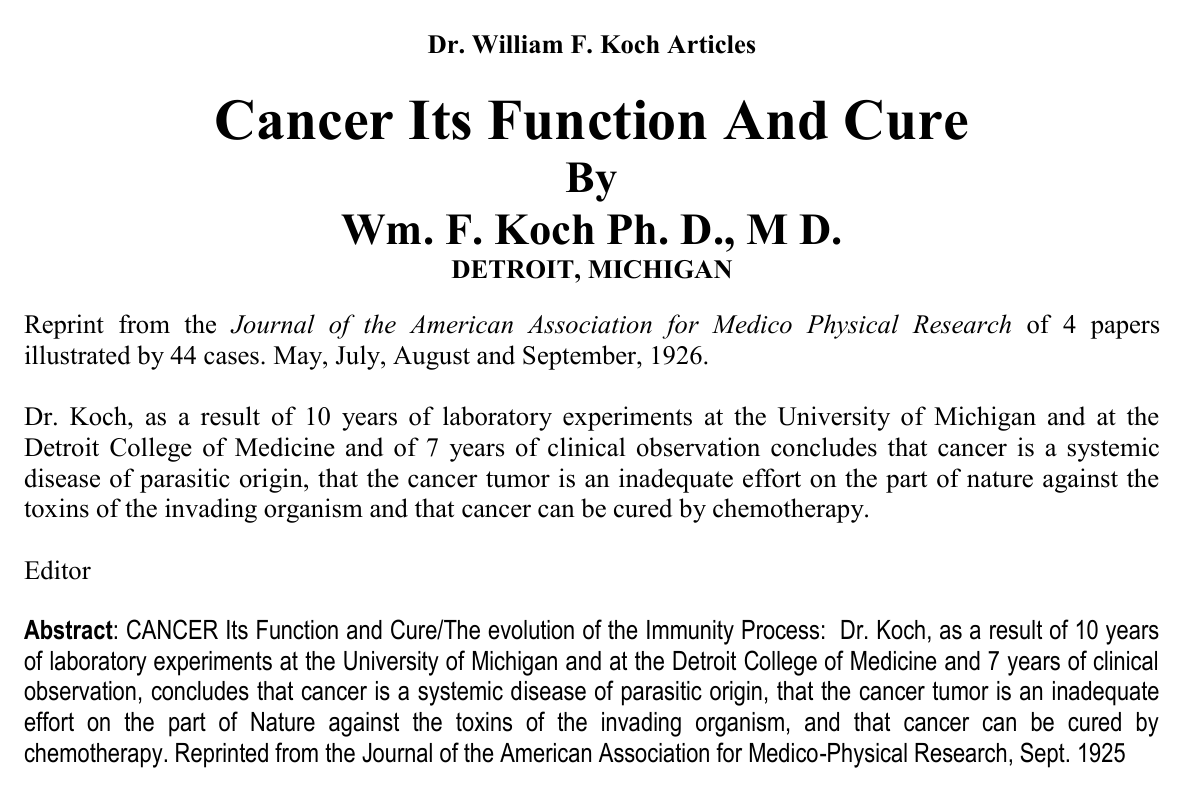
Will is a remarkable author, his work is supported and the bold statement wasn't from "a sense of relaxation" after supplementing silicic acid and eating a piece of cake, but in a document describing how 44 cases responded to his formula and minimal crutches.
Little did Will and supplement companies know that silicic acid capsules were only a lemon away from normalizing fermentation and healing cancer.
Brad, if you're reading this, I appreciate the recovery.
-
In another strike of openness to counterviews, the thread is now invisible to me, probably as a result of getting blocked by its creator. If I didn't have it linked elsewhere, I wouldn't be able to access it again. The discussions that appear are those that the originators allow them to.
I skimmed through the guy's article proposing the following antiviral arsenal:
- Riboflavin
- Sunlight
- Vitamin C
- Aspirin
The latter 3 are known to help and are widely promoted by other authors. I have some comments on the unique touch of his proposal: irradiated riboflavin.
He was conservative with the tone of this publication (from body to title), and included some of the consulted material. I suspect that the atypical behavior is because it was a heated mainstream topic, so he knew that he could get in trouble to announce its cure on social media. The inconsistency suggests awareness on where to tread.
"While there is some speculation that vitamin D is helpful for resisting viral agents, it is not our primary protective factor against them nor the factor which influences the seasonal occurrence of the flu or that of the current COVID-19 outbreak, and SARS as well occurred during the winter season (they’re all related to the flu, I believe). The one factor all this has in common, however, is sunlight. But, more specifically, how our bodies respond to or benefit from sunlight. There is an abundance of evidence that the B vitamin riboflavin, which is highly sensitive to light, is the agent which assists our bodies to restrain viral infections, and the mechanisms of action by which riboflavin helps protect us against both bacterial and viral pathogens is pretty well understood. Because riboflavin is extremely light sensitive our body uses it in pathways which regulate circadian rhythms. But when riboflavin is exposed to light, as it is in our skin when we get exposure to sun or bright light, it is actually energized from the interaction with photons and itself becomes irradiated. Then, in the irradiated state riboflavin is moderately to highly destructive to bacteria and viruses. These studies often show direct irradiation of riboflavin, but the same natural irradiation occurs simply from riboflavin created in our gut microbiome or obtained through diet or supplementation and the body’s exposure to natural sunlight. This is why the flu is restrained to seasonal patterns rather than being an ubiquitous affliction all year long, and why those with more Northerly climates or societies with prudish ideas of public skin exposure are being harder hit (or those with poor nutrition caused by economic inequality). Exposure to sufficient sunlight in humans during warmer months irradiates riboflavin in the body which in turn confers herd immunity (which is the collective resistance of an entire group of people against a pathogen on account of most of them being resistant) and thus prevents the spread of the flu until seasonal changes result in reductions of sun exposure thus impairing riboflavin irradiation which in turn allows such viruses to flourish."
The light absorption spectrum of riboflavin:
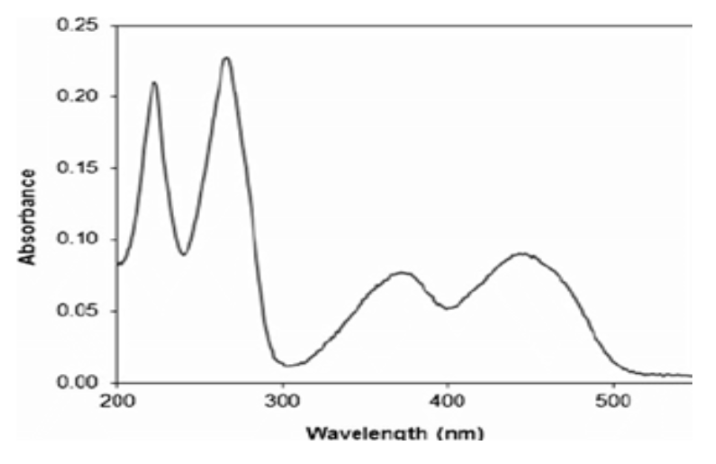
Peaks within the UVc, UVb, UVa, and blue light range. Image from one of the materials below.However, these shorter wavelengths are barred at the superficial layer of the skin and barely reach the layer beneath.
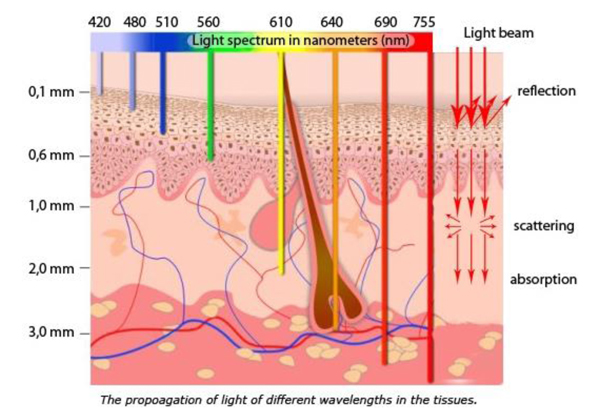
I didn't find the source.If you search for photodynamic therapy with flavins as photosensitizers, the results are almost entirely for irradiation of blood products (such as plasma, where the liquid is spread in a flat container) or for the treatment of external conditions. It's no wonder that the material linked by him falls into these superficial categories.
For light therapy in humans, I did find one experiment involving riboflavin in viral infections, but it was poorly-designed and not much can be concluded from it.
Riboflavin has many systemic effects and the population can be running low on it. How to claim success with photodynamic therapy relying on riboflavin as a photosensitizer if there was no group taking riboflavin without light application to compare? Also, people were asked to wear a dubious bracelet with 2 tiny blue LEDs for whole-body effects through circulation (which is comical), but the majority of LEDs were off from the absorption spectrum of flavins that they shared (also comical).
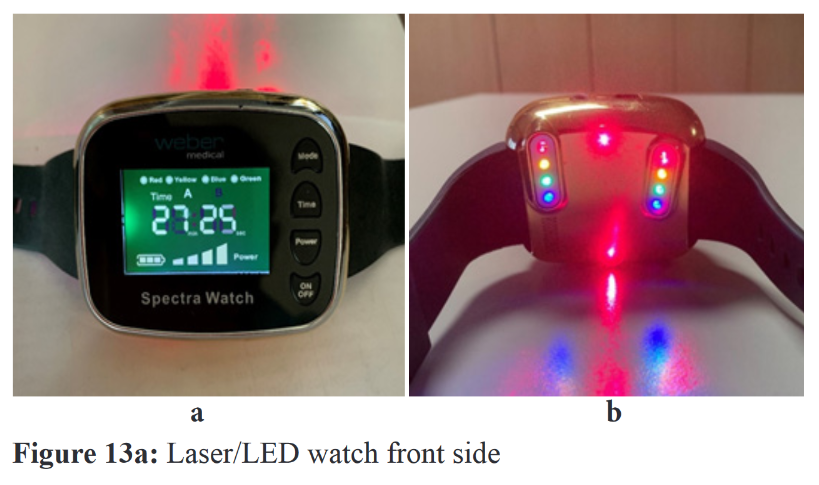
These wavelengths introduce confounders. For example, red light prevails, it enters tissues, and one hour for a session is a considerable exposure.
But they knew that higher chances to attack riboflavin were near the surface, asking people to use a riboflavin (5-phosphate) solution and later irradiating the regions:
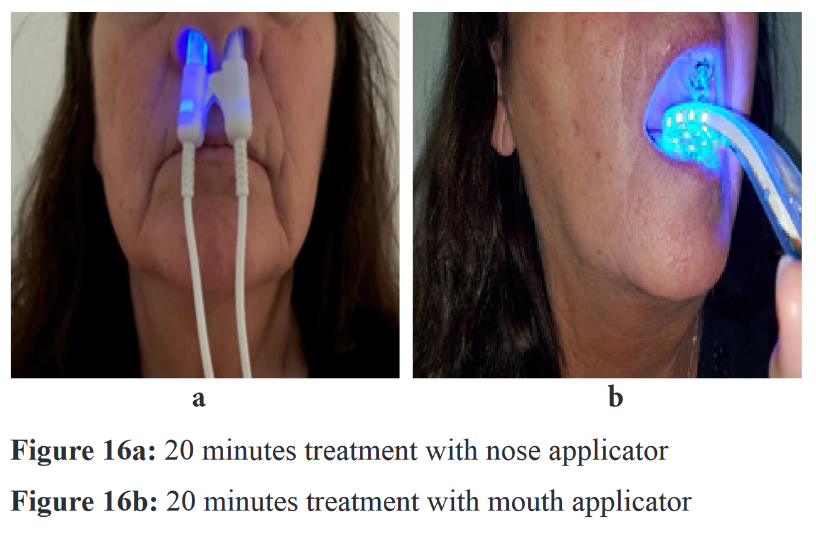
Even though they selected people in the early stages of infection, I'm not sure how useful irradiation was at that point, as people were already complaining of breathing difficulties. But these were the internal sites that they had accessible.
Benefits might have stemmed from fixing a long-standing riboflavin insufficiency or from light therapy in general.
To prevent infections from spreading, the body tries to contain them at mucosal barriers (areas of first contact), where shorter sunlight wavelengths won't hit and distant radicals won't reach, for being short-lived and quickly quenched. Riboflavin has to be next to targets because the reactions are local and instantaneous, involving radical attack. It's why photosensitizers that absorb red light are favored for internal tissues, and riboflavin is not one of them.
Therefore, the listed substances are of help, but the explanations are doubtful.
-
Check out his remarks on acne:
"Acne does not just occur on the face, although that is usually the source of our dislike since it muddies up our appearance. One of the reasons that acne is so concentrated on the face is because of where the iron excreted on the face comes from. Iron seems to be excreted in the fastest route possible via the skin, rather than circulating through the body, and while some organs like the liver and spleen will store iron, the rest of the body does not readily release it back into the blood stream once absorbed. In the case of the head, where large incidents of acne occurs, this iron comes from our most metabolically demanding organ—the brain. Since the brain is surrounded by skull, excreting iron would be extremely slow and difficult if it traveled through bone, so it instead goes through the face."
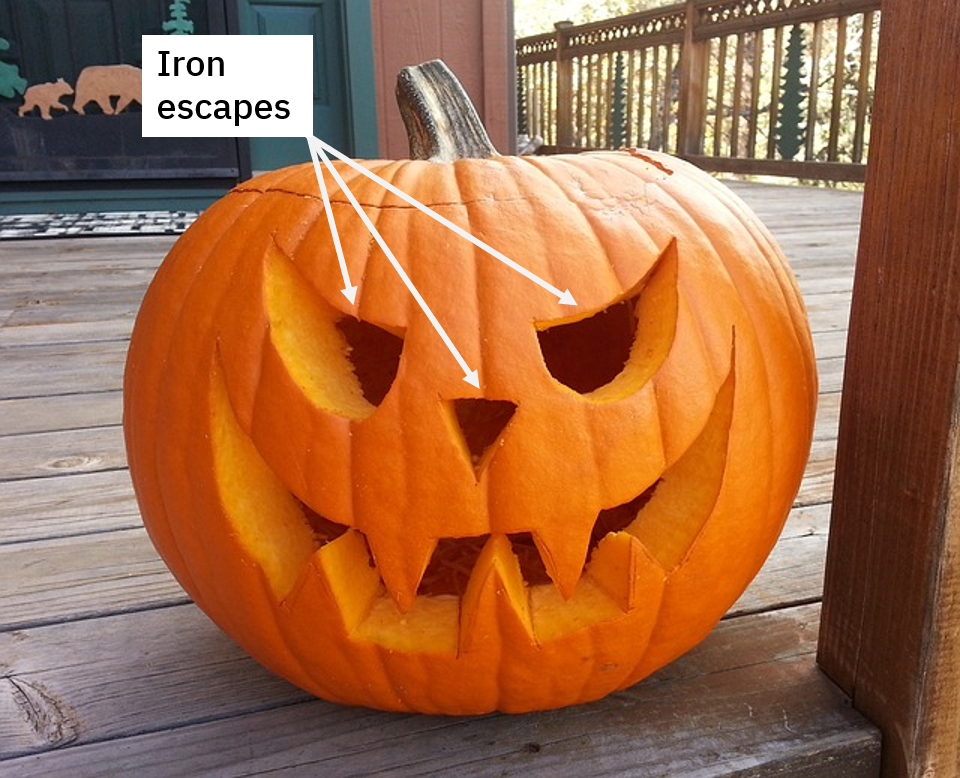
Want more? In line with pumpkins, how about his declaration that a lack of carotene is a main cause of gut problems?
"[..]carotene deficiency is one of the primary causes of gut dysbiosis and other gastrointestinal problems."
Yet more? He used to assert that the cause of body malodor is iron. Try to consume plenty of sulfur compounds (garlic, onion, eggs, acetylcysteine, thiamin) and smell the fragrance afterwards. It's iron mobilization?
It's an author who tells the audience that, by the time that you're 40, you're already old, proceeding to explain that you should accept that you'll live most of your life as an old person. But don't worry, you can be a healthy oldie.
Moving on, he asserted:
"The idea of a superfood is in reality wishful thinking, which is a nice way to cope with life but comes with some very serious consequences if it gets out of hand. If you struggle with health problems, limiting your diet is one of the absolute worst things you can do to yourself. This usually leads to the obsessive search for some miracle food you are missing, when in reality you are just missing all the foods."
By the same individual:
"A List of Helpful and Unhelpful Foods"
Where he stipulated that rice, potatoes and nixtamalized corn are foods that should be avoided most of the time. Oh, along with yogurt, vegan diets are categorized by him as "SHIT THAT GAVE YOU THE CANCER FROM WHICH YOU DIE IN 15 YEARS", which is funny considering how therapeutic diets for cancer adapt towards veganism.
He declared to someone pondering thyroid hormones supplementation, natural or synthetic:
"Thyroid supplements don't really do anything."
These are a few more examples that I remember stumbling upon, but we could go on. I hope that it's getting clearer where I'm coming from.
-
@Amazoniac said in BIOHACKING by Nathan Hatch, "F*** Portion Control":
In another strike of openness to counterviews, the thread is now invisible to me, probably as a result of getting blocked by its creator. If I didn't have it linked elsewhere, I wouldn't be able to access it again. The discussions that appear are those that the originators allow them to.
The last humanist is a transhumanist with a bridge to sell. No time like the present to waffle about it. And I will.
"The trick, William Potter, is not minding that it hurts."
-
@Amazoniac said in BIOHACKING by Nathan Hatch, "F*** Portion Control":
Also, people were asked to wear a dubious bracelet with 2 tiny blue LEDs for whole-body effects through circulation (which is comical), but the majority of LEDs were off from the absorption spectrum of flavins that they shared (also comical).
Oh good. Wearable green/red photoplethysmogram devices are quite the trend these days. Practically glued to many.
@Amazoniac said in BIOHACKING by Nathan Hatch, "F*** Portion Control":
Want more?
Always and thank you.

-
-
@Amazoniac that girl isn't even peaty
-
@Sugar Care to elaborate? I've been using Nathan's very "Peaty" recommendations for more than 2 months and my temperature has never been better. My daytime temps are between 98.4 and 99.1. My very hypothyroid husband is doing even better. His temp went from low 97's and is now usually around 99.1 throughout the day. And although we are both experiencing occasional discomfort in areas that are healing, we both have better energy and sleep has improved dramatically (just to mention a few improvements.) Nothing we have tried since I found Dr Peat 15 years ago, has helped us so much.
I started this thread to hear from others who have actually tried Nathan's strategies to learn what they experienced. It was hijacked by people drowning out the discussion (with MANY tldr posts) who haven't even read his book but have an obvious bias against him. Even if Nathan is wrong about one or two things (which he says he certainly may be) we are responding well to his recommendations. Dr. Peat (who saved my life as well as Nathan's, and who receives praise for this in his book) was also wrong about some things, which I won't go into here as others have discussed this elsewhere.
There are those here who want to learn and help others... And then there are the pot stirrers. Which are you?
